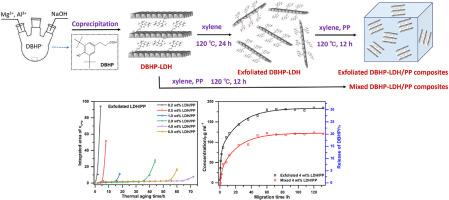Hybrid antioxidant based on exfoliated layered double hydroxides nanosheets with improved thermal stabilizing effects for polypropylene
IF 3.5
3区 化学
Q2 CHEMISTRY, INORGANIC & NUCLEAR
引用次数: 0
Abstract
An antioxidant (AO) agent, 3-(3,5-ditertbutyl-4-hydroxyphenyl) propionate anions (DBHP), intercalated between layered double hydroxides (DBHP-LDH) was prepared by coprecipitation method and then a part was delaminated in toluene to form exfoliated DBHP-LDH nanosheets. Both types of DBHP-LDH compositions, powder and exfoliated nanosheets were characterized by XRD, SEM and TEM, and subsequently incorporated into polypropylene (PP) as AO filler to improve the thermal stability of PP. The addition of DBHP-LDH affected the crystallization and melting behaviour as well as transmittance of PP, giving rise to its crystallinity improved but its transparency reduced. It was found that by incorporating either DBHP-LDH powder or exfoliated DBHP-LDH nanosheets the thermal decomposition temperatures and thermal aging resistance of PP were enhanced. Interestingly, between the two hybrid systems, it is however the exfoliated DBHP-LDH nanosheets that showed a better stabilizing effect for PP. This is attributed to the better dispersion regarding the exfoliated DBHP-LDH nanosheets, thus providing a more efficient radical scavenging capability. Even with its pronounced interface between PP chains and highly exposed nanosheets, about 30 % of DBHP was released from the exfoliated DBHP-LDH/PP compared to about 20 % DBHP migrated out of the conventional DBHP-LDH/PP films after 132 h test. This shows that the organic AO agent is well tethered to hydroxyl-bearing LDH nanosheets, thus opening new route to design functionalized filler for polymer from exfoliated LDH hybrid layers.

基于剥离层状双氢氧化物纳米片的杂化抗氧化剂对聚丙烯热稳定效果的改善
采用共沉淀法将3-(3,5-二叔丁基-4-羟基苯基)丙酸阴离子(DBHP)嵌入层状双氢氧化物(DBHP- ldh)之间,然后将一部分在甲苯中分层,形成脱落的DBHP- ldh纳米片。通过XRD、SEM和TEM对两种类型的DBHP-LDH组成物、粉末和剥离纳米片进行了表征,并将其作为AO填料加入聚丙烯(PP)中,以改善PP的热稳定性。DBHP-LDH的加入影响了PP的结晶、熔化行为和透光率,使其结晶度提高,但透明度降低。结果表明,添加DBHP-LDH粉末或剥离的DBHP-LDH纳米片均能提高PP的热分解温度和耐热老化性能。有趣的是,在两种混合体系中,脱落的DBHP-LDH纳米片显示出更好的PP稳定效果。这是由于脱落的DBHP-LDH纳米片具有更好的分散性,从而提供了更有效的自由基清除能力。即使在PP链和高度暴露的纳米片之间存在明显的界面,大约30%的DBHP从脱落的DBHP- ldh /PP中释放出来,而在132小时的测试后,大约20%的DBHP从传统的DBHP- ldh /PP薄膜中迁移出来。这表明有机AO剂可以很好地附着在含羟基LDH纳米片上,从而为从脱落的LDH杂化层设计聚合物功能化填料开辟了新的途径。
本文章由计算机程序翻译,如有差异,请以英文原文为准。
求助全文
约1分钟内获得全文
求助全文
来源期刊

Journal of Solid State Chemistry
化学-无机化学与核化学
CiteScore
6.00
自引率
9.10%
发文量
848
审稿时长
25 days
期刊介绍:
Covering major developments in the field of solid state chemistry and related areas such as ceramics and amorphous materials, the Journal of Solid State Chemistry features studies of chemical, structural, thermodynamic, electronic, magnetic, and optical properties and processes in solids.
 求助内容:
求助内容: 应助结果提醒方式:
应助结果提醒方式:


